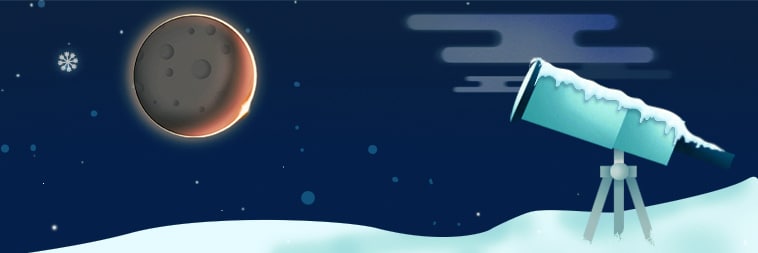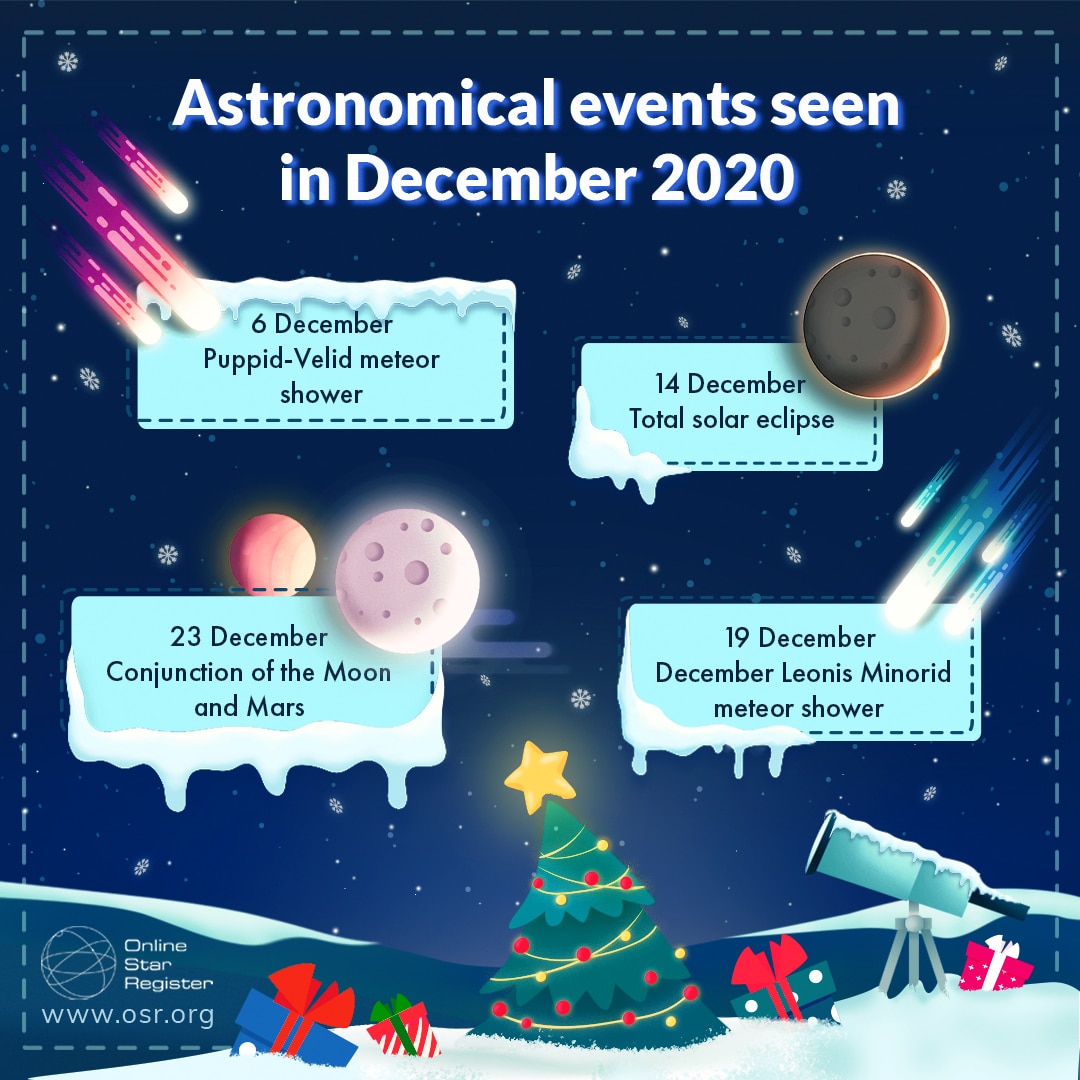The astronomical events of December 2020

December is a month with some amazing astronomical events to discover! Come explore the astronomical events of December 2020 with us! Learn more about the Puppid-Velid meteor shower, the total solar eclipse, the December Leonis Minorid meteor shower and the conjunction of the Moon and Mars!
Let us guide you through the astronomical events of December 2020. Comparable to November, we have handpicked four mesmerizing astronomical events for this month as well! While choosing these astronomical events we have done our best to pick some fascinating that are also visible with the naked eye. However, if you happen to have binoculars or a telescope at your disposal, feel free to use them. Be sure to write down the dates of the events in your calendar!

Astronomical Event #1: Puppid-Velid meteor shower
As the name suggests, the Puppid-Velid meteor shower is visible from the constellations Puppis and Vela. The constellation Puppis is also known as ‘The Stern’ and the constellation Vela is also known as ‘The Sails’. Both constellations are named after components of a boat and are part of the Heavenly Water constellation family.
The Puppid-Velid meteor shower takes place between Tuesday the 1st of December and Tuesday the 15th of December. You are able to see the peak of the meteor shower on Sunday the 6th of December. This peak allows you to see up to 10 bright meteors per hour flying at a speed of 40 km/s. You are able to see the peak from the meteor shower’s radiant point, the constellation Puppis and Vela, when it is above the horizon. Additionally, the number of visible meteors increases as the radiant point of the constellations becomes higher in the sky.
However, the Puppid-Velid meteor shower may be hard to spot in the Northern Hemisphere. This is because the radiant point of the meteor shower never rises above the horizon there. Nonetheless, if you are located in the southern part of the Northern Hemisphere, you are able to catch a glimpse of the meteor shower! In the Southern Hemisphere, the meteor shower is observable right after sunset. To locate the meteor shower look in a south-easterly direction and identify the star Canopus. This is one of the brightest stars in the night sky. When you look beneath Canopus, you are able to locate the meteor shower.
Astronomical Event #2: Total solar eclipse
Solar eclipses occur when the Sun, Moon and Earth are aligned in a straight line. When this happens, the Moon passes between us on Earth and the Sun and therefore blocks its light, causing a total solar eclipse. A solar eclipse always occurs about two weeks before or after a lunar eclipse. Usually, there are two eclipses in a row, but other times, there are three during the same eclipse season. The total solar eclipse of Monday the 14th of December is the second eclipse this season.
When a solar eclipse occurs, they are unfortunately not visible from the whole world. This is because the Moon is much smaller than the Earth, and the shadow it casts onto the Earth is never more than a few hundred miles across. The total solar eclipse of the 14th of December is visible from the Southern Hemisphere and especially from South-America.
The Moon passes in front of the Sun, creating a total eclipse of the Sun, visible from Chile and Argentina between 14:34 and 19:53 CET. At the same time, a partial eclipse is more widely visible from countries such as Brazil, Uruguay, South Africa, Namibia and more! Make sure to be on time when viewing this astronomical event, since it only takes about 2 minutes. Additionally, be careful when observing the sun! The Sun is the brightest object in the sky, and looking directly at it can cause permanent eye damage within seconds.
Astronomical Event #3: Leonis Minorid meteor shower
The Leonis Minorid meteor shower takes place in the constellation of Leo Minor. Leo Minor, also known as “The Small Lion” is one of the 88 constellations modern astronomers have divided the sky into. It’s part of the Ursa Major constellation family. Normally, the constellation Leo Minor is best seen in April (from latitudes +90° to -45°). However, in the month of December the constellation shines even brighter because of its Leonis Minorid meteor shower!
The Leonis Minorid meteor shower is caused by the Earth passing through streams of debris left behind in the wake of comets and asteroids. Meteor showers like the Leonis Minorid meteor shower are seen whenever one of these pieces of debris collides with the Earth’s atmosphere, typically burning up at an altitude of around 70 to 100 km. Because the Earth’s orbit passes through the same streams, annual meteor showers like the December Leonis Minorid meteor shower happen.
The December Leonis Minorid meteor shower is active from Saturday the 5th of December to Thursday the 4th of February. However, the peak rate of meteors is produced on Saturday the 19th of December. The constellation Leo Minor and therefore the December Leonis Minorid meteor shower are visible from both the Northern and Southern Hemisphere. You can see the meteor shower– in the constellation Leo Minor – whenever the constellation is above the horizon. Use the OSR Star Finder App to help you locate the Leo Minor constellation!
Astronomical Event #4: Conjunction of the Moon and Mars
It is time for another conjunction! As mentioned in the Astronomical events of November 2020: as the Moon and planets move along the ecliptic at different speeds, they pass each other from time to time. Therefore, conjunctions and appulses with the Moon are very common. The Moon even passes a conjunction with every planet roughly once a month! This month we will tell you about the conjunction of the Moon and Mars.
On Wednesday the 23rd of December the Moon and Mars share the same right ascension. However, we have not yet told you that a conjunction is an apparent phenomenon caused by the observer’s perspective! In other words, the two objects involved are not actually close to one another in space. So how does this work? Well, the times and details depend only very slightly on the observer’s location on the Earth’s surface. The differences are greatest for conjunctions involving the Moon because of its relative closeness to us on Earth.
The conjunction of the Moon and Mars is visible from the constellation Pisces. The Moon and Mars share the same Right Ascension (RA) of 01h26m40s but their declination (dec) differs. The dec of the Moon is at +04°16’ and the dec of Mars is at +09°50’. While the Moon and Mars are sharing the same right ascension, they are still too widely separated to fit within the view of a telescope. Nevertheless, it is still possible to see the conjunction with the naked eye or through a pair of binoculars!
Enjoy exploring the night sky!
We hope to have given you enough reasons to go out exploring the night sky with the astronomical events of December 2020! From the Puppid-Velid meteor shower, to the total solar eclipse, December Leonis Minorid meteor shower and the conjunction of the Moon and Mars. The night sky of December is full of Christmas magic: enjoy the season by going out stargazing!
Want to stay in the loop on the upcoming astronomical events?
